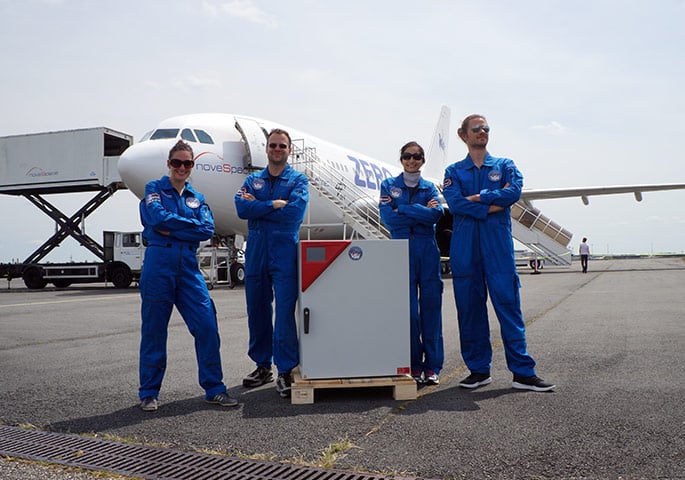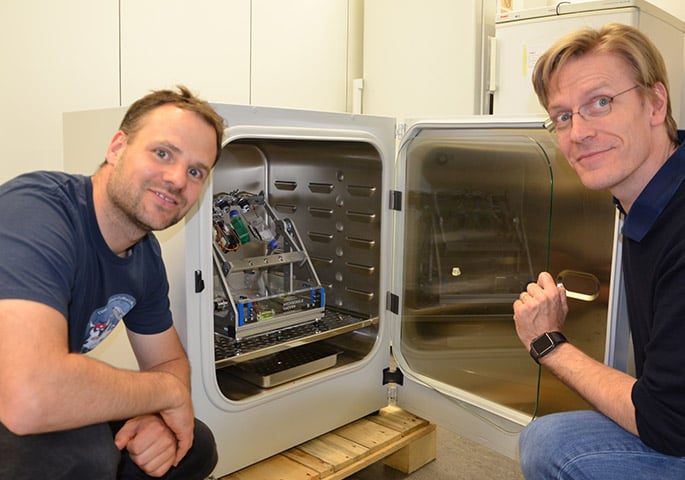Case Study Hochschule Luzern
Remit:
- Incubating cells
- Lots of space required
- Incubator should be easy to open
- The top priority is to avoid contamination
- Reliable sterilization
- Chambers must provide maximum and accurate performance in continuous operation
- The unit for simulating weightlessness must have space inside the chamber
BINDER solutions:
- Temperature range: Ambient temperature plus 4°C to 50°C
- Humidity range: up to 95% RH
- Alternative O2 control ranges: 0.2-20 vol. % O2 or 10-95 vol. % O2
- Auto-sterilization with hot air at 180°C
- Double-pan humidification system with condensation protection
- CO2 gas-mixing jet with Venturi effect
- Hot-air sterilizable CO2 sensor with infrared technology

The Institute of Medical Engineering at the Lucerne University of Applied Sciences and Arts has been carrying out research in the field of space biology.
The project is a truly exciting undertaking! The research team, led by Dr. Fabian Ille, is using a CO2 cabinet manufactured by BINDER. Cells from a bovine hoof are being incubated inside the cabinet at regular intervals until they are needed for a specific experiment. Animal protectionists can be reassured, because the hooves come from offal; they are not being harvested specifically for the purpose of the research being carried out in Lucerne. Recently, the cells were frozen and taken to the French city of Bordeaux by Dr. Simon Wüest and a team of researchers. The reason behind this trip was that the research team in Lucerne had been selected by the European Space Agency ESA to take part in parabolic flights over the Atlantic. Delighted to have received such an invitation, the
team loaded the CB 170 into a car ready to be set up in the laboratory on arrival in France. Once safely on site in Bordeaux, the cells were restored to their specified environment and made “match ready” for their first parabolic flight.
The company that partners with the ESA to provide flight and mission services is called Novespace. You can easily imagine how painstakingly the scientists from Lucerne had prepared for these tests under weightless conditions. Shortly before the parabolic flights, which were to last for a total of 3 hours, the cells were removed from the BINDER incubator and moved to flight hardware that had been prepared specifically for this purpose and was under controlled
temperature conditions. The scientists from Lucerne wanted to use the parabolic flights to investigate how the cells respond and adapt to mechanical forces. These findings will help them in future attempts to cultivate cartilage that is of a stronger and better consistency, for example. In other words, it might be possible to remove cells from a patient, reproduce them with this innovative new method, and then use them again in the treatment of human patients. “Weightless conditions are helping us to make significant progress,” says Dr. Ille, reflecting on the research project so far. In laboratory tests carried out already, Wüest and Ille have been able to demonstrate in very broad terms that this process could work in the future. In these tests, weightless conditions were simulated using a random position machine. Over a period of several days, the cells were treated inside the unit built by Wüest under simulated weightless conditions. These simulated weightless conditions were then in turn recreated under perfect cell growth conditions in a CB 170. Of course, the conditions are not those of genuine weightlessness – this is what the cells were to be exposed to during the parabolic flights in Bordeaux. And that’s exactly what happened:
31 parabolic flights were completed, during which the behavior of the cells in weightless conditions was observed. With the scientists on board, the aircraft followed a steep upward trajectory for 20 seconds. This was followed by 20 seconds of weightlessness before the aircraft followed a steep downward trajectory for 20 seconds. This process was repeated 31 times in succession. While it is already clear that the cells will have responded to the forces to which they were exposed during their time in the air, further evaluations are still under way at the Institute in Lucerne. “The next step will involve us being able to use the mechanisms deployed during parabolic flights for the subsequent stages of our research,” said Dr. Ille at the Institute of Medical Engineering in Lucerne. Both the research group and the Institute itself have an excellent reputation in Switzerland. Some of the Institute's employees also work frequently on ESA projects, communicating with Munich in Germany and Houston in Texas whenever their work involves the International Space Station (ISS). A number of the researchers working on trials involving cells in space have even been in direct contact with astronauts including Alexander Gerst, for example. Trials like these can then be moderated live from Lucerne.
The Institute of Medical Engineering is due to publish the results of its latest research soon, and we can’t wait to find out what they will reveal.


Advantages of CO2 incubators
- Maximum usable space with minimal footprint and excellent ease of use
- Minimum risk of contamination thanks to uncompromising hot-air sterilization
- Fanless, easy-to-clean hygienic interior
- Stable pH values thanks to driftfree CO₂ IR sensor technology